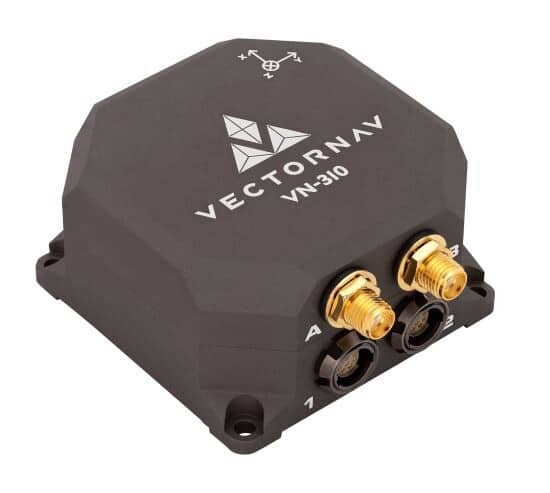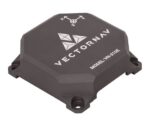VectorNav VN-310 Tactical Dual GNSS/INS
This tactical-grade, high-performance dual antenna GNSS-Aided inertial navigation system (Dual GNSS/INS) combines 3-axis accelerometers, 3-axis gyros, 3-axis magnetometers and two multi-band L1/L2/E5b GNSS receivers into a small ruggedized module to deliver a high-accuracy position, velocity and attitude solution under both static and dynamic conditions.
The VN-310 was designed for applications requiring highly accurate inertial navigation solution under both static and dynamic operating conditions, especially in environments with unreliable magnetic heading and good GNSS visibility. The VN-310 provides the ability to accurately estimate true heading (azimuth with respect to True North) in both static as well as dynamic conditions without any reliance on magnetic sensors. This is accomplished by utilizing GPS interferometry techniques, which measure the heading of the vehicle or platform without any assumptions regarding the vehicle dynamics (RTK moving baseline technique). This is a crucial feature for applications that require an accurate heading at startup, or in situations where insufficient motion is present to perform dynamic alignment.
The VN-310 is available in two packaging options: a precision milled, anodized aluminum enclosure designed to meet DO-160G standards. With dual I/O connectors the VN-310 offers maximum flexibility for interfacing with external GNSS receivers and IMUs. Alternatively the VN-310E is available in a miniature, board-mount option delivering tactical-grade IMU performance in an ultra compact package bringing unprecedented capability to SWaP-C constrained applications. See the Related Products tab for more.
Features
- GNSS Compass for static and low dynamic heading accuracy
- VectorNav Processing Engine (VPE) for disturbance rejection, adaptive filtering, dynamic filter tuning
- Hard/Soft Iron Compensation
- Coupled position, velocity and attitude estimates
- All sensors are individually calibrated for bias, scale factor, misalignment, and temperature over full operating range (-40°C to 85 °C)
- 184 Channel L1/L2/E5b GNSS Receivers
- RTK Capable: Support for External RTCM v3 Inputs
- Raw GNSS Data
- Exportable RINEX Data for PPK
- Raw Psuedorange, Doppler and Carrier Phase outputs
- 800 Hz IMU Data
- 400 Hz navigation and attitude data
- Yaw/Pitch/Roll
- Position and Velocity
- Coning and sculling integrals (ΔV’s, Δθ’s)
- Data output format: ASCII (VectorNav), NMEA-0183, Binary (VectorNav)
- Tactical Rugged IP 68 rated enclosure designed to DO-160G
- Vibration: MIL-STD-810G, EMI: MIL-STD-461G, Electrical: MIL-STD-1275E
- VectorNav Control Center freely available for easy setup, configuration and logging
- ITAR-Free
Ruggedized Packaging
The VN-310 features a precision milled, anodized aluminum enclosure designed to meet DO-160G standards. With dual I/O connectors the VN-310 offers maximum flexibility for interfacing with external GNSS receivers and IMUs. The VN-310 has an input voltage of 12 to 36 VDC power supply over a RS-422 interface.
Size: 56 x 56 x 31 mm
Power Consumption: < 2.5 watts
Weight: 200 g
Enclosed in a precision anodized aluminum enclosure, the VN-310 offers additional protection of the internal MEMs sensors and electronics. The use of precision CNC milled aluminum parts ensures that the axis alignment provided by the VectorNav factory calibration process is maintained during installation in its final configuration. Interfacing with the module is made through circular push-pull 10-pin connectors.
Dual GNSS-Compassing Algorithm
The VN-310 provides the ability to accurately estimate true heading (azimuth with respect to True North) in both static as well as dynamic conditions without any reliance on magnetic sensors. This is accomplished by utilizing GPS interferometry techniques, which measure the heading of the vehicle or platform without any assumptions regarding the vehicle dynamics (RTK moving baseline technique). This is a crucial feature for applications that require an accurate heading at startup, or in situations where insufficient motion is present to perform dynamic alignment.
Key Features of VectorNav’s GNSS-Compass Algorithms Include
- Magnetic independent
- Automatic transition between AHRS, INS and GNSS-Compass
- Adjustable GNSS antenna baseline lengths for shorter start-up times or increased heading accuracy
- Heading accuracy between 0.15° and 1.2° (RMS)
- Start-up in under 2 minutes
- Raw pseudorange, Doppler & carrier phase outputs


